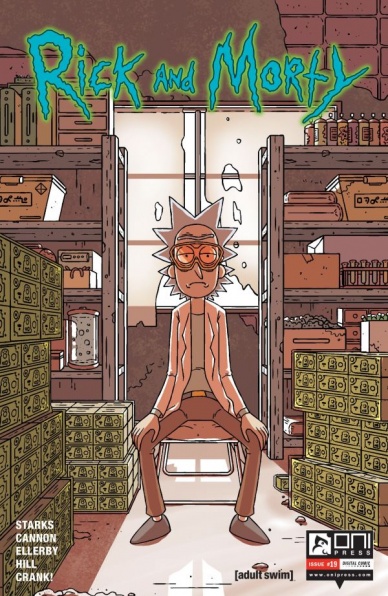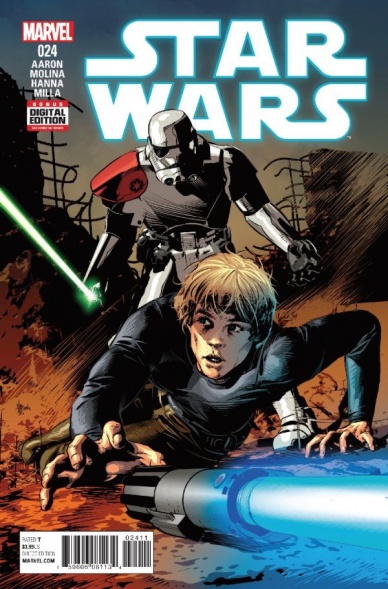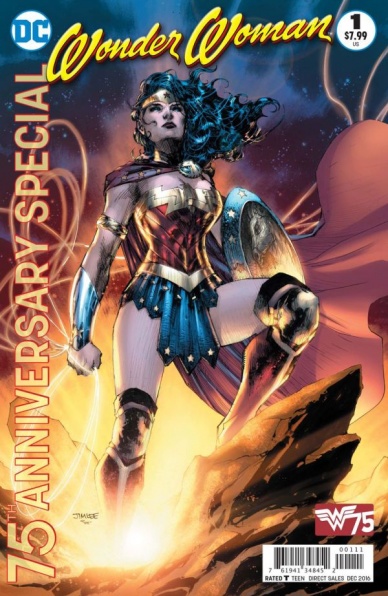There is a lot to cover on Wednesdays. We should know, as collectively, we read an insane amount of comics. Even with a large review staff, it’s hard to get to everything. With that in mind, we’re back with Wrapping Wednesday, where we look at some of the books we missed in what was another great week of comics.
Let’s get this party started.

Batman Beyond #1
Written by Dan Jurgens
Illustrated by Bernard Chang
Reviewed by Liam Budd
Batman Beyond is back after a brief hiatus caused by the DC Universe’s massive, line wide Rebirth. However, don’t let that big, blue banner fool you; this first issue is not the same fresh new start that its contemporaries have gone through. In fact, we pick up exactly where the last, pre-Rebirth issue left us: with Terry McGinnis back as Batman, now trapped under a mountain of rubble and debris. It is great to see Terry back under the cowl again, the majority of the last volume saw a time displaced Tim Drake as the future Batman, Terry has always been a favourite of mine thanks to his sharp wit and happy-go-lucky attitude. Even though the story or circumstances hasn’t changed whatsoever, I don’t think new readers will feel too confused as everything you need to know is simply and effortlessly dropped into the story without it overwhelming. Writer Dan Jurgens keeps the action moving at a fresh pace and doesn’t bog you down with any unnecessary continuity.
The plot itself is pretty standard, Batman narrowly escapes defeat only to head back to safety to devise a plan, but Jurgens does a good job in setting the stakes for later issues. He does dangle the possibility of the original Joker returning to future Gotham and we see a gang of street thugs how have all styled themselves after the villainous clown. I have to admit I have seen this done a whole lot before, from the ambiguousness of the Joker’s return to lookalike followers and it is kinda disappointing. For me “Batman Beyond” has always been a book where the normal rules don’t apply and gives writers and artists a chance to play around with a character and mythos we know far too well. What I will say however is that it feels Jurgens may take his story off in a complete left turn at some point.
Bernard Chang is a very capable artist who remains consistent and focused throughout. His designs are solid, if not a little rudimentary, and he captures excellent action scenes that don’t fall apart. Though I think Chang really excels when it comes to his page layouts. They are exciting and experimental while still retaining a tight grasp on the flow of the plot. The space between panels are filled with detail that doesn’t distract too much, but creates a more complete sense and tone of Gotham City decades from now. This book knows exactly when to push its own limits, yet always feels like a good, hearty superhero romp.
Final Verdict: 7.0 – A fine return. Like putting on that comfortable, old romper suit.

Generation Zero #3
Written by Fred Van Lente
Illustrated by Derek Cham & Francis Portela
Review by Ken Godberson III
Now that we have come to issue #3, I have to say this book has been leaving me with a lot of conflicting thoughts. I don’t find it bad, but I feel like it’s priorities can be a bit skewered. To put it in the simplest way possible: it feels like at times that the Generation Zero characters are supporting characters in their own book. That the creative team is more interested in Rook and Keisha than how these events affect the team. I mean, I appreciate the world building, but it feels like it comes at expense of character at times.
Take this issue for example. Looking for information, Cronus, Telic, Animalia and Keisha delve into the mind of one of Keisha’s classmates, Adele, the daughter of the most powerful man in town. It is a fun little parody of “Archie” (which is enhanced by “Jughead” artist Derek Cham taking on the dreamscape sections of the issue) and we do learn a good deal about Adele. But that’s kind of the problem: We learn a great deal about this character. Meanwhile, the leader of Generation Zero gets his personality explained in kind of an awkward exposition panel and I’m thinking: “Who is this book about and why is it not the titular characters?” Even the character moment Animalia gets feels like it’s framed to enhance Keisha’s development. Again, maybe this just comes from a place of impatience, considering I’ve been waiting since “Armor Hunters” for this group to get a book, but I would so rather have a look in the minds of the Generation Zero kids than this -at best- secondary character.
Continued belowDerek Cham brings the same kind of style from “Jughead” but with a little bit more of a twist on it, having no to little influence from the late Darwyn Cooke to form a clean cartoon work that can simulate wholesomeness with just a tinge of the sinister lying underneath. It’s further contrasted with Francis Portela’s more traditional superhero comic work and the more realistic creepy of Gamate the Super Fetus on the outside world (also, I can’t be mad at a book with a character called “Gamate the Super Fetus”. It’s against the law).
Final Verdict: 6.8- Not bad, but it feels like the book is more concerned with how the titular character affect others instead of the other way around.

Rick and Morty #19
Written by Kyle Starks
Illustrated by CJ Cannon
Reviewed by Robbie Pleasant
Rick’s broke bad as his penp-based drug empire continues to grow. In this issue, we learn how he carries out his deliveries, which is actually a rather clever method using characters from a fan-favorite episode. However, in a very Rick and Morty manner, it comes to an abrupt halt that’s very telling of Rick’s character. At the same time, Summer’s side story with the spacefaring pickup artist Peacock Jones manages to coincide quite nicely, tying it together in a satisfactory knot.
As with any comic based off a cartoon, it’s hard to read it without comparing the comic to the show. The dialogue manages to match the characters’ voices rather well, without relying on repeating lines from episodes of the cartoon (except, of course, for the Meeseeks, who always say “I’m Mister Meeseeks, look at me!” anyways). It’s easy to read the dialogue in the actors’ voices, and it’s littered with just the right amount of stuttering and belching as fitting for the characters.
Art-wise, it more or less captures the look of the show. The character designs for the humans are distinctive, while the aliens have unique looks, often insectoid or otherwise unworldly (with clever little touches, like giving the alien police chief a mustache in spite of his fly-like appearance). In fact, the art is more impactful and expressive with the alien characters, as the human ones feel just a bit flat.
However, it does include a few action sequences, which are remarkably violent for such a cartoonish looking comic, as befitting the series. As the stakes escalate in both plots, so does the action and in-panel and the comic’s pacing, before tying everything together in a pretty satisfying conclusion.
And just as a little added bonus, there’s a Mecha Morty vs kaiju fight after the main story. While it doesn’t really connect to any stories or provide anything new about the characters, it’s a giant robot fighting a huge monster in the middle of an alien city, and that makes for some good fun.
Final Verdict: 6.5 – a step up from previous issues, tying storylines together with some good humor, moments of cleverness, and fun action.

Star Wars #24
Written by Jason Aaron
Illustrated by Jorge Molina and Matt Milla
Reviewed by Matthew Garcia
With the latest issue of “Star Wars,” it’s not so much that we’re starting to see the seams as it is we’re starting to see them burst wide open. “Star Wars” #24 is . . . not good. To call this rough would be an understatement. To say it was a misfire would detract from problems the series as a whole has been having.
Up until this arc, Jason Aaron’s run has been at least consistently entertaining. He’s had a nice voice for the characters and even if his hands have been tied by Marvel and LucasFilm he’s delivered some fun and engaging scripts. But since ‘Vader Down,’ it feels like he’s lost what’s made his time on the book work. “Star Wars” #24 covers the exact same ground as “Star Wars” #23, with the Rebels trying to make it to this other planet in a stolen Star Destroyer while this badass stormtrooper team infiltrates them. Aaron’s following a formula now: offer up some quips, move the narrative along an inch, then throw in an action sequence. I mean, I get that there’s only so much he’s able to do, especially because we know where these characters are going to end up, but the effort Aaron exhibits here is so much less than he did earlier.
Continued belowIt also doesn’t help that this issue features some of the worst art I’ve seen in a mainstream comic. It was like Jorge Molina challenged himself to draw this entire issue in an afternoon. The characters are inconsistent, the line work sloppy and rushed. Sometimes Luke looks like he’s 12 and sometimes he looks like he’s 64. The expressions are a mess and don’t reflect either what the characters are saying or the action going on around them. The page compositions feel like they’ve been thrown down with no consideration of what came before or after, so there’s never any tension or momentum built up. There are times Molina attempts to tone the characters, but it ends up looking as if he just scratched out their faces and turned it all in.
With the recent conclusion of “Darth Vader,” maybe it’s also time for Marvel to consider wrapping up “Star Wars.” Aaron’s heart doesn’t feel like it’s in it anymore while Molina fails to even seem like he cares about the universe. “Star Wars” #24 is every flaw in the series amplified and projected, from its rushed illustrations to rote plotting to reliance on familiarity and nostalgia to keep you coming back.
Final Verdict: 3.0 – “Star Wars” should be better than this.

Wonder Woman #9
Written by Greg Rucka
Illustrated by Liam Sharp and Laura Martin
Reviewed by Jess Camacho
One of the most pleasing outcomes of Rebirth has been the “Wonder Woman” series. What was at one point an action heavy sort of God of War series turned into a Greek mythology mess is now very rooted in Wonder Woman’s ties to her home and the characters of her past. “Wonder Woman” #9 acts like the end of one phase of the series despite not being the true end of the arc. The attention shifts to Diana and Steve’s relationship and her journey back to Themyscira. There are a lot of wonderful moments between Diana and this cast of characters with a scene at the mall and her conversation with Steve Trevor as the true standouts.
Liam Sharp’s art continues to get better. I haven’t been very down on his art but one of the things I think he can slip up with a bit is in making characters’ faces feel a bit flat or squished. I love how much heart is felt in this issue as he’s really good at creating tension and raw emotion between his characters. Martin’s colors continue to be on the darker side but there’s a boldness to how she approaches the book.
Final Verdict: 8.0 “Wonder Woman” continues to be a true stand out in the Rebirth line.

Wonder Woman 75th Anniversary Special
Written and illustrated by Various
Reviewed by Brian Salvatore
These sort of comics – samplers, if you will – are something that we don’t see nearly enough in comics nowadays. If you wanted to introduce a new reader to Wonder Woman, there are far worse ways than putting a copy of this book in their hands. Obviously, one oversized comic can’t possibly contain all, or even a quarter, of the character’s essence, but the various stories and pinups contained herein are a solid place to start.
That said, this is a very unusual comic, especially based off the solicitations: we didn’t get the promised Brian Azzarello/Cliff Chiang piece, which is odd, as they have the most acclaimed Wonder Woman story of the 21st century. Even if their characterization was not your cup of tea (like many Wonder Woman enthusiasts), it seems odd not to include them. In fact, aside from current “Wonder Woman” writer Greg Rucka and Gail Simone, this issue was far more about newer talent representing Diana, which is fine, but feels a little strange, given the purpose of the comic.
But some of that new talent dazzles: Fabio Moon and Riley Rossmo can draw Diana anytime they please, and each of their stories did absolutely different things with the character. Hope Larson’s story about the DCU Ikea being a setting for a story about anger was a hilarious and brilliant decision, and some of the pinups (especially Marcio Takara’s generations of Wonders) were absolutely stunning. After years in the wilderness, it is nice to see the enthusiasm that so many of DC’s creators seem to have for Diana right now.
Continued belowThe one part of the book that was shrewd, but a little disconcerting, was the fact that two of the stories were excerpts from books DC is currently pushing – Jill Thompson’s new graphic novel and Renae de Liz’s digital “The Legend of Wonder Woman” series. While I loved both of these stories, and while both told very different Diana stories, it took away a space for original content, and for many Wonder Woman fans, led to having duplicate stories instead of new material.
But those are minor quibbles: while the $7.99 price point is a bit much, you get a ton of really fun Wonder Woman content in this anniversary special, and I hope that DC does this with more of their characters in the future.
Final Verdict: 8.1 – A wonderful celebration.






